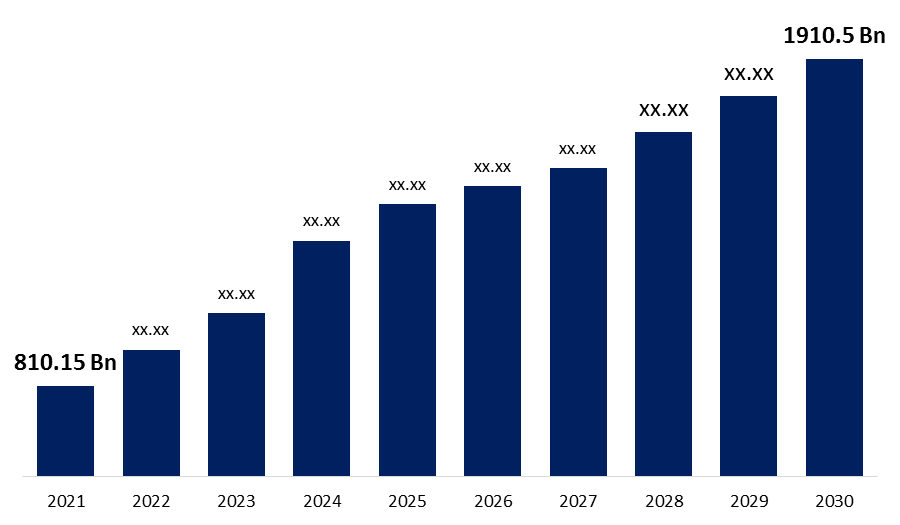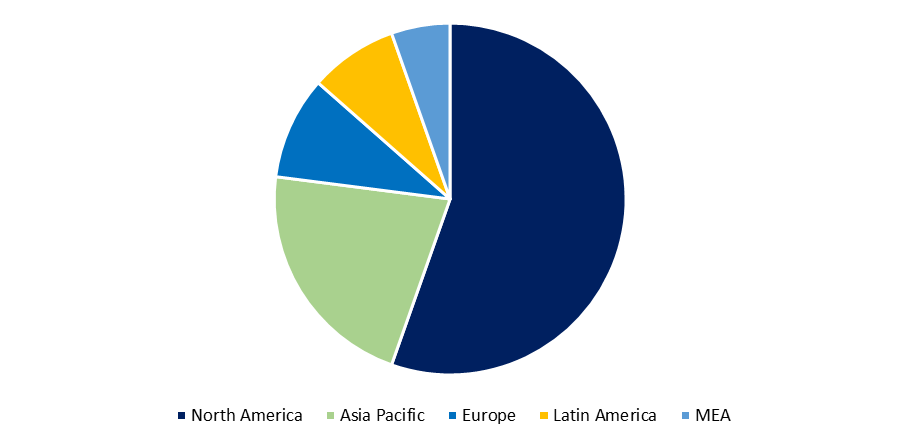Global International E-commerce Market Size, Share & Trends, COVID-19 Impact Analysis Report, By Product (Fashion, Electronics, Publishing, & Media, Beauty & Cosmetics, and Others), By Business Model (Business to Business(B2B), Business to Consumer(B2C), Consumer to Consumer(C2C), and Business to Government (B2G)), By End User (Business, Government and Individual), and By Region (North America, Europe, Asia-Pacific, Latin America, Middle East, and Africa), Analysis and Forecast 2021 - 2030
Industry: Electronics, ICT & MediaInternational E-commerce: Overview
The Global International E-Commerce Market Size was valued at USD 810.15 billion in 2021 and is expected to reach USD 1,910.5 billion by 2030, growing at a CAGR of 14.30% during 2021-2030. Major factors driving the market growth include the rising demand for rising internet penetration across various countries and growing e-commerce expenditure is expected to aid in the growth of the market.

Get more details on this report -
The chart you've provided shows a projected growth in some financial metric (in billion dollars) from 2021 to 2030. Here’s a breakdown of the details:
- 2021: The starting value is approximately 810.15 Bn.
- 2022 to 2029: Each subsequent year shows increases in value.
- 2030: The projection reaches about 1910.5 Bn.
International E-commerce Market Statistics:
- The trend appears to be exponential growth over the years, indicating significant positive change in whatever metric is being represented.
- The data suggests consistent growth year over year, reflecting strong performance or increasing demand.
- The overall increase from 810.15 Bn to 1910.5 Bn highlights a robust upward trajectory.
The international e-commerce industry is rapidly gaining traction around the world as a result of the increased adoption of online sales channels and increased internet penetration in various regions. There were 4.66 billion active internet users worldwide in January 2021, accounting for 59.5 percent of the global population. 92.6 percent (4.32 billion) of this total used mobile devices to access the internet. The region's internet penetration has resulted in a rapid increase in the number of internet users over the last year. The majority of the increase in internet users can be attributed to China, which has the largest population in the Asia region, with the United States ranking second.
COVID-19 ANALYSIS
As we can see in the early stages of the outbreak, there is a decline in discretionary products, as demand for discretionary products is experiencing a short-term drop. As people became more concerned about the economy and their finances. However, discretionary e-commerce sales are not resuming in the market. People are still avoiding going to retail shops after the market reopened, increasing the share of e-commerce in total retail sales. Looking at the year-to-date numbers in mid-April 2021, the overall increase in the market is about 11% globally compared to the same period last year. This demonstrates that any sluggishness in the retail industry is only temporary. There is always a lot of demand in this market. In terms of supply, many merchants are forced to close their doors entirely to conform to social distancing requirements. At the same time, once they reopen their business, they immediately see orders coming in again. Although it will take time to recover from the impact of closures on their revenues. International demand patterns indicate that international e-commerce will play a significant role in their recovery.
International E-commerce: Trend
Increasing Advancement in Information and Communication Technology Boost Market Growth
The international e-commerce market is expanding rapidly due to the increasing availability and affordability of information and communication technology infrastructure and services. It is becoming a key factor that is fuelling its growth as broadband internet connections become more widely available. In many developing economies, the lack of secure online payment options for international e-commerce is a major impediment to e-commerce development. Payment and supply chain logistics are becoming increasingly important as technology advances. Concurrently, economies are experiencing network expansion in general, which presents challenges to the development of international e-commerce in small developing countries. ICT affordability and accessibility, bandwidth availability, online payment options availability, delivery infrastructure, and economies of scale are among the major economic factors and conditions.
Global International E-commerce Market Report Coverage
| Report Coverage | Details |
|---|---|
| Base Year: | 2021 |
| Market Size in 2021: | USD 810.15 billion |
| Forecast Period: | 2022 to 2030 |
| Forecast Period CAGR 2022 to 2030 : | 14.30% |
| 2030 Value Projection: | USD 1,910.5 billion |
| Historical Data for: | 2017 to 2020 |
| No. of Pages: | 179 |
| Tables, Charts & Figures: | 106 |
| Segments covered: | By Product, By Business Model, By End User, By Region |
| Companies covered:: | Newegg Inc., Lowe’s, Amazon, Walmart, Alibaba, eBay, Macy’s, Wayfair, Best Buy, Target, Home Depot, Zalando, and Etsy amongst several others. |
| Growth Drivers: | 1). Increasing Advancement in Information and Communication Technology Boost Market Growth. 2). Rising Mobile & Internet Penetration Propel Market Growth |
| Pitfalls & Challenges: | Payment Risk May Restraint Market Growth |
Get more details on this report -
International E-commerce: Drivers
Rising Mobile & Internet Penetration Propel Market Growth
Given that the current population of humans on Earth is estimated to be 8.5 billion, this means that more than 41% of the world's population is connected via the internet. However, there are significant regional differences in user distribution, with East Asia having 923 million internet users while Africa and the Middle East have lower user figures.
China tops the list of countries with the most internet users. More than 854 million of China's estimated 1.38 billion population are online, owing to the country's ongoing and rapid economic development as well as a cultural proclivity toward technology. Other notable emerging markets include India, which is expected to have more than 636 million internet users in the coming years, and Indonesia, which is expected to have 144.2 million citizens surfing the World Wide Web.
In terms of internet users, China, India, and the United States outnumber all other countries. China has over 854 million internet users, while India has approximately 560 million. Both countries still have large portions of their populations that are not connected to the internet.
International E-commerce: Restraint
Payment Risk May Restraint Market Growth
E-payment is the primary source of differentiation between e-business and traditional business. Furthermore, online payments in e-business are closely related to the security of the business's margins. In traditional business, capital is frequently handled by dealers in banks with appropriate credentials, posing minimal risk to asset safety. Because of the small number of transactions in cross-border e-business transactions, buyers and sellers do not go through complex guarantee processes. Furthermore, they are unaware of each other's credit standing. As a result, there is a significant cross-border e-business compensation risk, which may result in buyers not receiving their products or sellers not receiving their payment. China does not have specific rules in place for cross-border payments in e-commerce.
Market Segmentation:
The Global International E-commerce Market is segmented by Product, Business Model, End User, and Region. Based on the Product, the market is categorized into Fashion, Electronics, Publishing, & Media, Beauty & Cosmetics, and Others. Based on Business Model, the market is categorized into Business to Business(B2B), Business to Consumer(B2C), Consumer to Consumer(C2C), and Business to Government (B2G). Based on End User, the market is categorized into Business, Government and Individual. Based on the Region, the market is categorized into North America, Europe, Asia-Pacific, Latin America, Middle East and Africa.
Market Segmentation: By Region
Based on the Region, the International E-commerce market is categorized into North America, Europe, Asia-Pacific, Latin America, Middle East and Africa.

Get more details on this report -
The North America region is dominating the market share of the global International E-commerce market owing to its characteristics, cloud solutions have been significantly contributing to the expansion of digital commerce in North America. Cost-effectiveness, a small IT investment, seamless interfaces, and accessibility are a few of them. Businesses in this area are aiming to update outdated systems with more cutting-edge ones so they can enter new markets with pop-up shops and solutions. The market for digital commerce software is being driven by retailers' efforts to enhance customers' shopping experiences. However, the Asia Pacific region is anticipated to grow at the highest CAGR during the forecast period owing to the rising expansion of infrastructure facilities and the rising number of internet users in the Asia Pacific region are anticipated to drive market expansion. A growth in the region's demand for B2B e-commerce adoption is also anticipated, which may be ascribed to an increase in smartphone adoption and mobile internet penetration.
Competitive Landscape
Leading players in the international e-commerce market include Newegg Inc., Lowe’s, Amazon, Walmart, Alibaba, eBay, Macy’s, Wayfair, Best Buy, Target, Home Depot, Zalando, and Etsy amongst several others.
The vendors in this market are majorly focusing on promoting premium brand products on their platforms to generate e-commerce awareness for which the companies are adopting different marketing strategies such as celebrity endorsements to support the international e-commerce in the region.
Recent Development
· In February 2019 - The first self-driving, self-securing, and self-repairing database in the market, Oracle Autonomous Database was introduced by Oracle India. It helps to improve and expedite business choices.
· In January 2018 - Adobe introduced micro services based on commerce across its clouds. The 20 micro services are anticipated to be portable, adaptable, and compact programmes with features like wish lists, shopping carts, and inventory queries. One of the first companies to offer these features as micro services is Adobe, which offers marketing-focused clouds.
International E-commerce: Key Players
- Newegg Inc.
- Lowe’s
- Amazon
- Walmart
- eBay
- Macy’s
- Wayfair
- Best Buy
- Rakuten
- Target
- Shopify
- Home Depot
- Zalando
- Etsy
Report Overview
The scope of the report includes a detailed study of regional markets for Global International E-commerce. The report covers the Global International E-commerce market segmented by Product, Business Model, End Users, and region. It reveals the market situation and future forecast. The study also covers the significant data presented with the help of graphs and tables. The report covers information regarding the competitive outlook including the market share and company profiles of the key participants operating in the Global International E-commerce market.
Powered Lower Limb Orthosis Market, Regional Analysis
- North America
- US
- Canada
- Mexico
- Europe
- Germany
- Uk
- France
- Italy
- Spain
- Russia
- Rest of Europe
- Asia Pacific
- China
- Japan
- India
- South Korea
- Australia
- Rest of Asia Pacific
- South America
- Brazil
- Argentina
- Rest of South America
- Middle East & Africa
- UAE
- Saudi Arabia
- Qatar
- South Africa
- Rest of Middle East & Africa
Need help to buy this report?